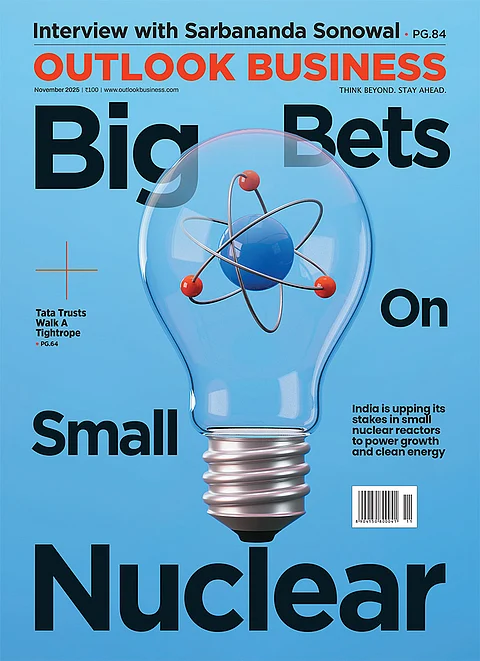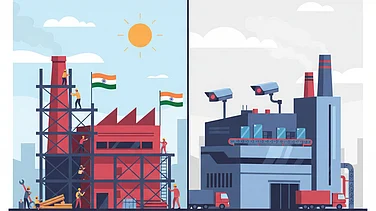With the economy slowing, incomes stagnating and prices surging, 2024 was anything but a happy year for India’s salaried middle-class, which groped for relief that never came. In its Economic Review for November the government has sought to deflect the blame for the weak demand on the RBI’s tight monetary policy that put a lid on liquidity.
Economists, however, differ. “In fiscal year 2025, the fiscal support to growth was significantly lower with capital expenditure declining across the Centre and state governments,” says Gaura Sengupta, chief economist at IDFC First Bank. “During the period, the Centre’s capex is expected to trail target levels by a trillion rupees. To compensate, the capex target needs to be increased in FY26.”
Even if the RBI were to take the imprudent, easy-money route, it is unlikely to arrest the slowdown in the long-run. As Anitha Rangan, an economist at Equirus Group, says, "the effect of any tax cut measure would be short-lived unless accompanied by significant structural reforms, such as job creation, capital expenditure, and production-linked incentive (PLI) schemes."
While holding the capex at an unchanged level of Rs 11.1 lakh crore in the 2024 Union Budget, Finance Minister Nirmala Sitharaman had maintained that the focus was on job creation to support growth, reflecting a long-term approach to steering the economy.
However, experts like Sankhanath Bandyopadhyay, economist at Credit Rating Agency, believe that there are no alternatives to sops such as tax concessions in the immediate context: “We need to keep in mind that COVID shattered the middle-class worldwide. The aggregate demand problem in India is due to lack of purchasing power of common people.”
No Relief to Taxpayers
The Interim Budget in February, left income tax rates unchanged. Key deductions, like the Rs 1.5 lakh limit under Section 80C and housing loan interest, also remained unchanged, offering little relief to taxpayers. Worse was to follow with the Union Budget increasing the long term capital gains tax from 10 per cent to 12.5 per cent and short term capital gains tax from 15 per cent to 20 per cent.
Despite rising healthcare costs the deduction limit for medical insurance premiums, which taxpayers can claim in a financial year, has remained static for a decade. This decreases the real value of the deduction over period, imposing a bigger financial burden on the middle-class. However, the Finance Minister raised the standard deduction for salaried employees to Rs 75,000, from Rs 50,000 under the new income tax regime, yielding a gain of up to Rs 17,500.
Much like the Budget, the 55th GST Council Meeting in December too belied expectations, leaving the taxes on health and life insurance premiums untouched. Amid expectations of big-ticket reforms, discussions around new 18 per cent GST on caramelised popcorn took centre-stage.
With GST collections rising sharply from Rs 11.37 lakh crore in 2020–21 to Rs 20.18 lakh crore in 2023–24, experts warn that higher taxes could further reduce consumer spending and worsen economic slowdowns.
India’s private consumption fell from 58.1 per cent of its GDP in 2021-22 to 55.8 per cent in 2023-24. Meanwhile, urban consumption has been declining for five quarters. In May 2024, Rajiv Bajaj, MD Bajaj Auto, identified rising costs of vehicles in India due to higher taxation, as a worrying trend.
Notably, the decline in automotive sales, a key indicator of domestic demand, is primarily driven by the affordable sub-Rs 10 lakh category, which has been languishing for several quarters now. Two-wheelers, which provide affordable mobility to the country's majority, attract 28 per cent of GST.
In April 2024, data released by the Society of Indian Automobile Manufacturers (SIAM) showed that domestic sales of cars and two-wheelers at the entry level were far from reaching their pre-pandemic peak. The commuter motorcycle segment under 75-110 cc saw an 8 percent Year-over-Year growth to 5.6 million units in 2023-24.
However, it remained well below the pre-pandemic peak of 8.422 million units registered in 2018-19. Despite a festive boom during October-November, the sales again dipped in December as Vahan portal revealed that retail vehicle registrations reported 19 per cent year-on-year decline in the first 17 days of December 2024. Growth in the two-wheeler category was down by 24 per cent during the same period.
"In India why do we have to pay a GST of 28 per cent on vehicles meant for the common man? In all the ASEAN countries it is between 8 and 14 per cent. In India is should be no more than 12 per cent,” said Bajaj.
Rising inflation, particularly in food prices, has forced middle- and lower-income households, still recovering from the shocks of COVID, to cut back even on essentials, a trend leading to a slowdown in earnings across major consumer companies. Meanwhile, even as India Inc’s profit grew four times, the real wages remain well-below the country’s inflation rate, as per The Indian Express newspaper. The compounded annual wage growth rate (CAGR) between 2019 and 2023 ranged between 0.8 per cent and 5.4 per cent whereas inflation has grown at an annual average rate of 5.7 per cent over the last five years.
New Year, New Hope
Next month will witness two mega policy making events: The Union Budget and the RBI’s Monetary Policy Committee (MPC) meeting. Market watchers and economists widely anticipate a rate cut with inflation cooling and the need to support growth rising, in the policy review this time under a new governor, former Revenue Secretary, Sanjay Malhotra.
Meanwhile, industry body representatives have sought a reduction in personal income tax rates during a pre-budget meeting to ensure higher disposable incomes in the hands of the nation's middle-class. According to a Reuters report, the Centre is considering a tax cut for individuals earning up to Rs 15 lakh per annum in the upcoming budget to stimulate consumption. Economists believe the government must also expand its capital expenditure. Sengupta of IDFC believes that the government must “incentivise job creation in the formal sector and promote the real estate industry as it supports both capital expenditure and employment creation.”
The key question is whether the Centre will intervene to stimulate India’s slowing economy or will it rely on the RBI to do the heavy lifting. What is certain is that next month’s decisions will determine how prosperous the “New Year” would be for India’s middle-class.


























